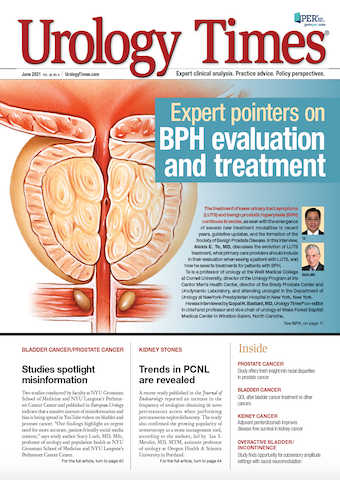Publication
Article
Urology Times Journal
QOL after bladder cancer treatment vs other cancers
Author(s):
"This study provides important and clinically useful information that can be used to plan the intensity of treatment and counsel our patients regarding the cancer-related and QOL-related outcomes after treatment," writes Badar M. Mian, MD.
Badar M. Mian, MD

Although much of our attention in treating patients with bladder cancer (BC) is focused on cancer control, patients and their families must face other real-life issues that significantly impact survivorship. Despite being of critical importance to the patients, health-related quality of life (HRQOL) after various treatments for BC has remained underappreciated until recent years. Previous studies on HRQOL have been small and limited in scope, focusing mainly on radical cystectomy (RC) or radiation therapy (RT) for muscle-invasive bladder cancer (MIBC) and the related urinary, bowel, and sexual dysfunction. The HRQOL after non–muscle-invasive bladder cancer (NMIBC) and how BC-related QOL compares with other pelvic cancers are not well understood.
To address this gap in knowledge, Catto et al conducted a population-level study of HRQOL of patients between 1 and 10 years since BC diagnosis.1 The authors used a mail-in survey between January 2007 and December 2016 of patients diagnosed in 22 British National Health Service hospitals (representing 11% of the population). Patients with BC were identified through the National Cancer Registration and Analysis Service and were asked to participate in the survey. Several tools were used such as general HRQOL questionnaire including questions related to mobility, self-care, daily activities, pain/discomfort, and anxiety/depression. The European Organization for Research and Treatment of Cancer (EORTC) QOL questionnaire (which includes functional and symptom scales, financial impact, global QOL scale) was combined with EORTC-NMIBC QOL questionnaire to assess urologic symptoms.
Of the 3279 eligible participants, 1796 (55%) completed the survey. The average age of respondents was 75 years (11% were younger than 65 years), and only 1.0% were non-White. The nonresponders were older and lived in underserved areas. At least 1 long-term comorbid condition was reported by 76%, and 11% reported 4 or more comorbidities (hypertension, 24%; coronary artery disease, 14%; and diabetes, 11%). Of the respondents, 48% (n = 868) had treatment for NMIBC (transurethral resection of bladder tumor [TURBT]±intravesical treatment), 23% underwent RC alone, 17% received RC plus neoadjuvant chemotherapy (or prior BCG), and 7% underwent RT with curative intent.
Of the respondents, 69% reported at least 1 problem on the general HRQOL, with the most frequently reported issues including difficulty with mobility, daily activities, and pain/discomfort. The overall mean self-assessed health (SAH) score was 74 (out of 100), and it did not differ based on cancer stage (MIBC or NMIBC) or extent of treatment, eg, SAH score ranged from 75 in the RC-alone group to 71 in the RT group.
Regardless of treatment type, increasing age and number of comorbidities were associated with increasing frequency of reported problems in all general HRQOL domains (mobility, self-care, daily activities, and pain) with the exception of anxiety/depression, which was highest in the younger age groups. Also, multimodal treatment combinations (TURBT with/without intravesical treatment, RC with/without chemotherapy) did not impact HRQOL.
On the cancer-related QOL questionnaire, the mean global health score was 71 (out of 100) after RC compared with 69 after radical RT. No meaningful differences in scales or symptom scores were noted among the treatment groups (TURBT, RC, or RT) or cancer stages (I to IV). However, worse functional and symptom scores were noted with increasing age and comorbid conditions. Of note, a higher rate of financial difficulties was reported by younger patients—and especially in the younger patients undergoing RC—compared with those undergoing TURBT.
On the BC-specific QOL measures, bladder symptom scores varied considerably across different treatments and tumor stages. Worse urinary symptoms were reported following RT compared with TURBT, whereas urinary symptoms in participants following RC with neobladder were similar to those following TURBT. Also, addition of intravesical therapy to TURBT did not worsen the urinary symptoms. Worse problems with body image, sexual intimacy, sexual enjoyment, and male sexual problems were reported by those who underwent RC, which worsened with increasing age. The missing responses regarding sexual problems in women did not allow for an accurate evaluation of this domain.
Because only 12% of patients underwent ileal neobladder, the comparisons of HRQOL between various urinary diversions were not informative due to mismatch in sample size, age, and health of patients. Interestingly, there were no significant differences in HRQOL scores in each questionnaire based on the time from diagnosis of BC, possibly suggesting that HRQOL may stabilize after some time.
The general HRQOL was worse after treatment for BC than for prostate or colorectal cancer treatment across all domains except anxiety/depression. The differences were greatest for problems with mobility and daily activities. For example, 48% of men with bladder cancer reported problems with mobility compared with 36% of men with colorectal cancer, 34% of men with prostate cancer, and 25% of the general male population.
Higher rates of sexual dysfunction were reported by men with bladder cancer, and significant financial toxicity was reported in younger patients. Compared with the general population and those with other common pelvic cancers, patients with BC reported lower HRQOL. The use of multimodality treatment did not appear to adversely affect the HRQOL. Participants who received TURBT alone or TURBT with intravesical therapies and those who underwent RC alone or RC with systemic chemotherapy had similar urinary symptoms and sexual function scores. “It was reassuring that overall QOL in our participants was mostly associated with their age and fitness, rather than treatment intensity or treatment received. This should reassure patients and encourage them to make the safest choice - with respect to their cancer”, remarked lead author James Catto, MBChB, PhD, professor of urological surgery at theProfessor James Catto from the University of Sheffield in the United Kingdom.
Financial toxicity reported by younger patients receiving RC or TURBT was significantly higher than that reported by older patients; this is likely related to disruption in employment due to frequent visits required for cystoscopy and/or intravesical therapy or the temporary inability to work for 2 to 3 months or longer after radical surgery. Catto pointed out, “The most frequent problems in younger men < 65 years was loss of sexual function,” and that “financial toxicity for both NMIBC and MIBC was common in younger, still employed men, both of which require consideration when planning treatment.” Knowing the expected deterioration in sexual function and financial health associated with BC treatment should prompt early and specific counseling and mitigative strategies. Although more intense treatment schedules may not have affected many of the HRQOL measures, deintensification of treatment may be necessary to reduce financial toxicity.
As the investigators pointed out, the survey was conducted among participants in a public (free) health care system, and because the nonresponders were typically older and from underserved areas (both of which contribute to poor HRQOL), the full extent of BC-related decline in HRQOL of the population is likely to be worse than reported in the study.
The variation in overall HRQOL depending upon patient age and comorbidities may not be surprising, but the lack of difference in HRQOL based on treatment type, disease stage, or time from diagnosis may be unexpected. Trimodal therapy for BC is being discussed with increasing frequency to avoid radical surgery. The patient-reported HRQOL noted in this study showed no significant differences in outcomes between RC and RT; however, the cohort undergoing RT was small and older. Could an individual with high-grade NMIBC be offered either TURBT plus intravesical BCG or radical cystectomy with sufficient equipoise? This study provides important and clinically useful information that can be used to plan the intensity of treatment and counsel our patients regarding the cancer-related and QOL-related outcomes after treatment.
Reference
1. Catto JWF, Downing A, Mason S, et al. Quality of life after bladder cancer: a cross-sectional survey of patient-reported outcomes. Eur Urol. 2021;79(5):621-632. doi:10.1016/j.eururo.2021.01.032






















